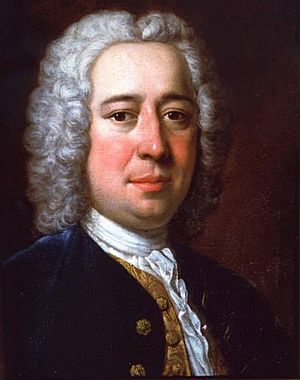Nicola Porpora facts for kids
Nicola Antonio Porpora (born August 17, 1686 – died March 3, 1768) was a famous Italian composer and singing teacher. He lived during the Baroque period, which was a time of grand and dramatic music. Porpora is most famous for teaching some of the greatest singers of his time, like Farinelli and Caffarelli. He also taught other composers, including the well-known Joseph Haydn.
Contents
Biography
Porpora was born in Naples, a city in Italy. He studied music at a school called Poveri di Gesù Cristo in his hometown. At that time, another famous composer, Alessandro Scarlatti, was very popular in Naples.
Early Career and Teaching
Porpora's first opera, Agrippina, was performed successfully in Naples in 1708. His second opera, Berenice, was shown in Rome. Over his long career, he wrote many more operas. He often worked as a maestro di cappella (which means "music director") for rich people. This was because just writing operas wasn't enough to make a living back then.
However, Porpora's lasting fame comes from his amazing skill at teaching singing. From 1715 to 1721, he taught at two music schools in Naples: the Conservatorio di Sant'Onofrio and the Poveri di Gesù Cristo. There, he trained many famous singers, including Farinelli, Caffarelli, and Salimbeni.
In 1720 and 1721, he wrote two serenades (a type of musical piece) with words by a talented young poet named Metastasio. This was the start of a long working relationship between them. By 1722, his operas were so successful that he left his teaching jobs at the conservatories.
Travels and Challenges
In 1725, Porpora tried to get a job at the court of Charles VI in Vienna, but he wasn't hired. So, he moved to Venice, where he continued to compose music and teach at schools like La Pietà.
In 1729, some people in London who didn't like the composer George Frederick Handel invited Porpora to start a new opera company. They wanted it to compete with Handel's company. Unfortunately, Porpora's company was not successful. Even when his famous student Farinelli joined in the 1733–1734 season, the company in Lincoln's Inn Fields (called the "Opera of the Nobility") went bankrupt.
Time with Haydn
From 1748, Porpora worked as a Kapellmeister (another type of music director) at the court in Dresden. But he had problems with another very successful opera composer, Johann Adolph Hasse, and Hasse's wife, the singer Faustina. Because of these problems, Porpora left Dresden in 1752.
After leaving Dresden, Porpora hired a young musician named Joseph Haydn as his assistant and valet (a personal servant). Haydn was just starting his career in Vienna. Haydn later said that he learned a lot from Porpora about singing, composing, and the Italian language. He also said Porpora taught him "the true fundamentals of composition."
In 1753, Porpora and Haydn spent three months together at a spa town called Mannersdorf am Leithagebirge. Porpora was there to continue giving singing lessons to the mistress of the Venetian ambassador.
Later Life and Legacy
Porpora returned to Naples in 1759. From this time on, his life became difficult. His style of music was becoming old-fashioned, and his last opera, Camilla, was not a success. He also stopped receiving his pension (regular payment) from Dresden. He became so poor that money for his funeral had to be collected from a special concert.
However, even though Porpora died poor, his most famous students, Farinelli and Caffarelli, were living very rich lives. Their wealth was largely due to the excellent singing lessons they had received from their old teacher.
Porpora was also known for being good with languages. He spoke Latin, Italian, French, German, and English. He was also celebrated for his clever conversations and was well-read in literature.
Besides about 40 operas, Porpora also wrote oratorios (large musical works for voices and orchestra, usually on a religious theme), solo cantatas (pieces for a single singer with instruments), motets (choral pieces), and vocal serenades. Some of his larger works that have been recorded include his 1720 opera Orlando, the oratorio Gedeone (from 1737), one mass, his Venetian Vespers, and the operas Germanico in Germania (1732) and Arianna in Nasso (1733).
Works
Vocal music
Operas
- See List of operas by Nicola Porpora.
Oratorios
- Davide e Bersabea (London 1734)
- Il Gedeone (Vienna March 28, 1737)
- Il Verbo in carne (Dresden 1748)
Cantatas
- 12 cantatas for solo voice and continuo dedicated to Frederic, Prince of Wales (London, 1735)
- I. D'amore il primo dardo
- II. Nel mio sonno almen (Il sogno)
- III. Tirsi chiamare a nome
- IV. Queste che miri o Nice
- V. Scrivo in te l'amato nome (Il nome)
- VI. Già la notte s'avvicina (La pesca)
- VII. Veggo la selva e il monte
- VIII. Or che una nube ingrata
- IX. Destatevi destatevi o pastori
- X. Oh se fosse il mio core
- XI. Oh Dio che non è vero
- XII. Dal pover mio core
Instrumental music
- 6 Sinfonie da camera op. 2 (London 1736)
- 12 Sonatas for violin and bass op. 12
- 12 Triosonatas for 2 violins and bass (Vienna 1754)
- Sonatas for cello, violins, and Bass
- Concerto for cello, strings and bass
- Concerto for cello, 3 violins and bass
See also
 In Spanish: Nicola Porpora para niños
In Spanish: Nicola Porpora para niños



